Atomic radii - Study guides, Class notes & Summaries
Looking for the best study guides, study notes and summaries about Atomic radii? On this page you'll find 133 study documents about Atomic radii.
Page 2 out of 133 results
Sort by

-
AP Chemistry Review Practice Test.
- Exam (elaborations) • 8 pages • 2024
-
Available in package deal
-
- $12.99
- + learn more
AP Chemistry Review Practice Test. isotope - CORRECT ANSWER element with a different number of neutrons mass spectrometry - CORRECT ANSWER mass of various isotopic elements to create a mass spectrum graph avogadros number - CORRECT ANSWER 6.022 E23 ? L/mol - CORRECT ANSWER 22.4 L empirical formula - CORRECT ANSWER simplest ratio of the molecules making up a compound molecular formula - CORRECT ANSWER actual formula for a substance coulombs law - CORRECT ANSWER the amount o...
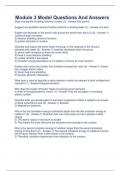
-
Module 3 Model Questions And Answers
- Exam (elaborations) • 4 pages • 2023
- Available in package deal
-
- $9.99
- + learn more
Module 3 Model Questions And Answers State one benefit of adding chlorine to water (1) - Answer-Kills germs Suggest one possible hazard of adding chlorine to drinking water (1) - Answer-It is toxic Explain the decrease in the atomic radii across the period from Na to Cl (3) - Answer-1) nuclear charge increases 2) electron shielding remains the same 3) greater attraction to nucleus Describe and explain the trend, down the group, in the reactivity of the Group 2 elements with water (5) -...

-
TEAS ATI 7 Exam Questions and Answers 100% Pass
- Exam (elaborations) • 18 pages • 2024
-
- $13.49
- + learn more
TEAS ATI 7 Exam Questions and Answers 100% Pass How many valence electrons does an atom have if the atom has an atomic number of 10? -Answer-8 valence e- because it ends with 2s2 2p6 How many valence electrons will an atom have if the atom is located in Group VIA of the periodic table? -Answer-VI=6 An atom located in which of the following groups on the periodic table of elements will most likely gain electrons from another atom in a chemical reaction? -Answer-The higher the valence elec...
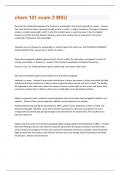
-
chem 141 exam 2 MSU Questions with 100% Correct Answers | Verified
- Exam (elaborations) • 5 pages • 2024
- Available in package deal
-
- $7.99
- + learn more
Describe the relationship between the frequency, wavelength, and velocity (speed) of a wave. - AnswerThe more times the wave is passing through a point in space = a higher frequency, the higher frequency creates a smaller wavelength, which is why the smallest wave is a gamma wave, it has the highest frequency and the shortest distance between waves, the velocity can be measured in m/s and is composed of frequency and wavelength Calculate any one (frequency, wavelength, or velocity) given the...
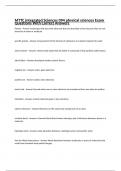
-
MTTC integrated Sciences 094 physical sciences Exam Questions With Correct Answers
- Exam (elaborations) • 11 pages • 2024
- Available in package deal
-
- $11.99
- + learn more
Plasma - Answer ionized gas that has some electrons that are described as free because they are not bound to an atom or molecule specific gravity - Answer measurement of the density of substances in a liquid compared to water atomic theory - Answer a theory that states that all matter is composed of tiny particles called atoms. John Dalton - Answer developed modern atomic theory negative ion - Answer anion, gains electrons positive ion - Answer cation; loses electrons ionic bon...

-
Basic reactor theory lesson 1&2 PHYSICS/SCIENCE LATEST EDITION 2024/25 GUARANTEED GRADE A+
- Exam (elaborations) • 27 pages • 2024
-
- $11.39
- + learn more
Basic reactor theory lesson 1&2 PHYSICS/SCIENCE LATEST EDITION 2024/25 GUARANTEED GRADE A+ Binding energy The energy equivalent of the mass defect; the amount of energy released when a nucleus is formed from its component parts, also the amount of energy that must be supplied to a nucleus to separate it into its components Bohr model A model of the atom proposed by Nobel Laureate Niels Bohr in 1913 that describes the atom as composed of a dense, positively-charged nucleus with electrons orbi...

-
Test Bank For Chemistry 10th Edition International Edition by Kenneth W
- Exam (elaborations) • 955 pages • 2023
-
- $32.98
- + learn more
Chapter 3—Chemical Equations and Reaction Stoichiometry MULTIPLE CHOICE 1. Which of the following is not a consequence of the Law of Conservation of Matter? a. It provides a basis for balancing chemical equations. b. It means that there will be no observable change in the quantity of matter during a chemical reaction. c. As a result, there will be the same number of moles on both the reactant and the product side of a balanced equation. d. It can be stated as "matter is neither creat...
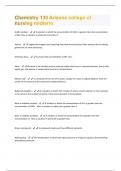
-
Chemistry 130 Arizona college of nursing midterm Questions With 100% Correct Answers.
- Exam (elaborations) • 11 pages • 2024
- Available in package deal
-
- $7.99
- + learn more
Acidic solution - A solution in which the concentration of H3O+ is greater than the concentration of OH- Also, a solution in which pH is less than 7. Anions - negatively-charged ions (meaning they have more electrons than protons due to having gained one or more electrons). Arrhenius base - increases the concentration of OH- ions. Atom - An atom is the smallest unit of ordinary matter that forms a chemical element. Every solid, liquid, gas, and plasma is composed of neutral or ionized atom...
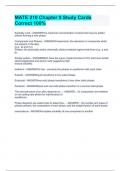
-
MATE 210 Chapter 9 Study Cards Correct 100%
- Exam (elaborations) • 1 pages • 2024
-
Available in package deal
-
- $10.49
- + learn more
Solubility Limit - ANSWERThe maximum concentration of solute that may be added without forming a new phase. Components and Phases - ANSWERComponents: the elements or compounds which are present in the alloy (e.g., Al and Cu) Phases: the physically and/or chemically distinct material regions that form (e.g., α and β). Simple system - ANSWERBoth have the same crystal structure (FCC) and have similar electronegativities and atomic radii suggesting high mutual solubility. Isotherm - AN...
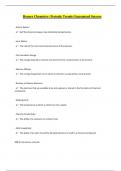
-
Honors Chemistry: Periodic Trends Guaranteed Success
- Exam (elaborations) • 8 pages • 2024
-
Available in package deal
-
- $9.89
- + learn more
Honors Chemistry: Periodic Trends Guaranteed Success - Atomic Radius: ️ Half the distance between two identically bonded atoms. - Ionic Radius: ️ The radii of the most commonly found ion of the element. - First Ionization Energy: ️ The energy required to remove one electron from a neutral atom of an element. - Electron Affinity: ️ The energy change that occurs when an electron is acquired by a neutral atom. - Number of Valence Electrons: ️ The electrons that are ava...

How much did you already spend on Stuvia? Imagine there are plenty more of you out there paying for study notes, but this time YOU are the seller. Ka-ching! Discover all about earning on Stuvia


